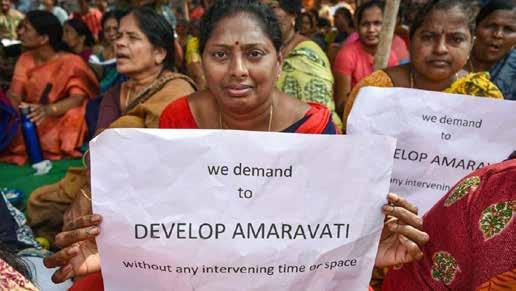
45 minute read
Newscan
NEWSCAN Andhra Capital Row: Explained
Ama ravati: Andhra Pradesh will soon become the first state in independent India to have three capital cities at the same time. The mandate of the Andhra Pradesh Assembly on the Andhra Pradesh Decentralisation and Equal Development of All Regions Bill 2020, paves way for the incumbent Chief Minister YS Jagan Mohan Reddy to develop Amaravati as the Legislative Capital, Kurnool as the Judicial Capital and Visakhapatnam (Vizag) as the Executive Capital of the state. When Hyderabad, which was Andhra’s capital till 2014, was absorbed in the newly formed state of Telangana, the then Chief Minister of Andhra Pradesh N Chandrababu Naidu proposed and planned Amaravati to be the state capital and allocated a budget of `400 crore for the same. Naidu, during his tenure as CM, was able to build an interim government complex, High Court building and a permanent Legislative Complex along with commissioning new apartments of lawmakers and officers. But with the change in the state government, the focus is now to distribute growth across three cities in different corners of the state. The rationale behind this is to utilise the capital in a way that homogenous growth is ensured across the state. The Executive Capital Visakhapatnam is 700 km from Kurnool, the Judicial Capital which is located 400 km away from the Legislative Capital Amaravati. Amaravati-Kurnool are 370 km apart.
Advertisement
What would the decision entail for urban Andhra? With the decision, the state government has made it clear that uniform development of the state is at the top of the government’s agenda. Considering the fact that cities contribute vastly in the economic development of a region, the government will be developing these three cities as economic hubs, thereby, ensuring growth opportunities in the surrounding areas as well. “We do not want to develop one area utilising all our available financial resources while other areas suffer due to lack of funds,” said YS Jagan Mohan Reddy, Chief Minister, Andhra Pradesh. But the government will have to deal with major financial issues before moving forward with the decision. For the fiscal year of 2018-19, the state had an outstanding debt of `2.52 lakh crore with the State Bank of India (SBI), which is expected to rise to `3

lakh crore.
Certain flaws become apparent from an administrative view as well. The government has not laid out any specific plan for the improvement of transit between the cities which are located far away from each other.
Why masses have rejected the proposition The decision has been facing widespread opposition across the state. The protestors are majorly farmers who believe the formation of the three capitals would leave them short-changed. When the proposal of making Amaravati as the capital city of the newly formed state was put forth, the then government also procured the lands of the farmers around the city for infrastructural development, promising that the value of their lands would increase after the construction. Now, they are not sure that government will not deliver all the infrastructure in Amaravati that the then government had promised which would have enabled appreciation in the value of their plots.
Another issue is related to the expenditure of around Rs 5000 crore by the previous government on infrastructure such as roads and buildings for offices and quarters for government officials in the city. What will be the fate of that money is a major question left unanswered.
NEW DELHI: In an attempt to assure whether advance batch automated plants can address emission of pollutants due to burning of waste tyres in pyrolysis industries, the National Green Tribunal (NGT) has asked the Central Pollution Control Board (CPCB) to conduct a study within a time frame of four months revealing all the essential data required. As per the NGT bench headed by Justice Adarsh Kumar Goel, NGT Chairperson, the study would be carried out by the CPCB along with National Environmental Engineering Research Institute (NEERI ) and Indian Institute of Technology (IIT ) Delhi. The two organisations are also required to address the environmental concerns, caused due to the absence of proper management of End-of-Life Tyres/Waste Tyres (ELTs). The bench has been hearing a petition filed by Social Action for Forest & Environment (SAFE). The plea demanded for complete ban of ELTs in Pyrolysis Industries due to non-implementation of the existing laws by the Pyrolysis plants, resulting in an adverse environmental impact. In pyrolysis, old tyres are recycled through a thermochemical process carried out under high temperature to produce industrial oil and other matters. The CPCB informed the green tribunal that as per an action taken report from the state pollution control boards, there are presently 678 pyrolysis units in 19 states where old tyres are recycled, following which the green tribunal passed the directions. Of the 678 tyre pyrolysis units, 270 were aligned with the environmental norms, informed the CPCB.
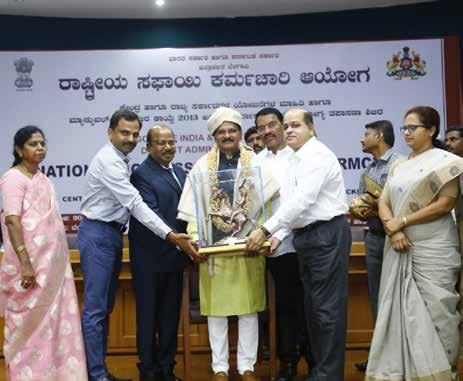
BELGAUM: National Commission for Safai Karamcharis (NCSK) held an awareness program for the Prohibition of Manual Scavenging Act, 2013 in Suvarna Soudha Belagavi, Karnataka on 20 th January. Manhar Valjibhai Zala, Chairman of the commission was present for the occasion along with Anil S Benake, MLA from Belgaum North.
Telangana marks its presence in BEE’s State EE Index 2019 HYDERABAD: The State Energy Efficiency (EE) Index was released by the Bureau of Energy Efficiency (BEE), in association with Alliance for an Energy-Efficient Economy (AEEE). Telangana marked its presence in efficient use of energy under the categories of Transport and Industry. The Index grouped states based on their aggregated Total Primary Energy Supply (TPES) required to meet the states’ actual energy demand. Telangana was placed in Group II along with Haryana, Kerala, Punjab, Andhra Pradesh, Delhi, Chhattisgarh, West Bengal and Jharkhand.
Under the ‘Municipalities’ section of the Index, where Telangana stood first in Group II , only Assam, Haryana, Tamil Nadu and Telangana have set an energy saving target for municipal services. All these targets are specifically for energy efficient street lighting except for the state of Tamil Nadu, where an overall target has been set. Telangana stood third in energy efficiency in Transport sector as the state had performed well in various state initiatives for electric mobility and energy efficiency measures in State Road Transport Corporations and government businesses. According to the Index, 20 states and all Union Territories (UTs) have notified establishment of Nodal Agencies for the promotion of charging infrastructure for EVs. Telangana stood fourth in the ‘cross sector energy efficiency’ section of the Index. The highest score of five was awarded to Kerala and Odisha. The main differentiators in the top performing states are initiatives taken with respect to strengthening of communication with the State Energy Department, a greater focus on creating awareness, and focus on R&D activity related to energy efficiency.
C ty Image ‘WE ARE STILL ALIVE’
Delhi Exhibition Flags Climate Change
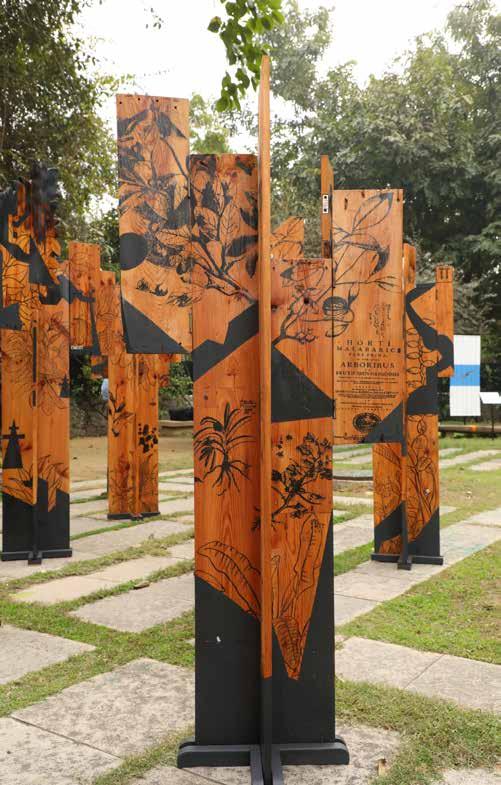
The exhibition “We are Still Alive”, addressing climate change issues in the sculpture garden of India International Centre (II C) served as an invitation to Delhi artists who have experienced the poor air/water quality, congestion, pollution in the city, change in the temperature and water levels. The public art project was organised to create awareness and highlight these matters. Each work encourages viewers to think about these important issues that affect their health, food and quality of life.



Mohali to get waste-toenergy plant
Captain Amarinder Singh, Chief Minister of Punjab, has given the go ahead to the building of a 7 MW waste-to-energy plant in Mohali. The plant would be built in an area of over 50 acres in Simgauli of Mohali district and would run under the build-ownoperate model and take at least two years for completion. The waste-to-energy plant would generate energy from 600 tonnes of waste per day collected from Mohali and Patiala and would be a significant contribution to the implementation of the State Action Plan on Climate Change (SAPCC).
Delhi-Panipat RRTS to extend to Karnal
Government of Haryana has approved the extension of Sarai Kale Khan, DelhiPanipat corridor of Regional Rapid Transit System (RRT S) to Karnal city with a stoppage at Gharaunda. With the construction of the corridor, the 103 km road connecting Delhi and Panipat with 17 stations would be extended to 130 km to reach Karnal, enhancing the transportation facilities within the National Capital Region, which includes Karnal. The authorities also announced development of a total of eight corridors of RRT S under the Functional Plan on Transport of NCR-2032. The first phase would see the construction of Delhi-Meerut, Delhi-Panipat and Delhi-SNB (ShahjahanpurNeemrana-Behror).
Delhi’s population more than some countries
NEW DELHI: The population count of the Indian capital has crossed the count of population of many countries like New Zealand, Greece, Sweden, Zimbabwe and the Netherlands. Delhi population is more than two crores now. A report released by the Election Commission of India revealed the stats with the announcement of the upcoming assembly polls.
Kazakhstan is the largest country by area with fewer people than the Indian capital. It is spread over an area of 27 lakh square kilometer and has an estimated 1.88 crore people. This means its population is 93.4 per cent of Delhi’s population, while its area is 1,819 times as large. Similarly, Zimbabwe has 73.9 per cent of Delhi’s population and is 261 times the area.
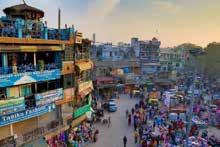
Although, there are many countries having a population more than that of Delhi but many of these have a slightly higher population and are over thousand times bigger in land area. Canada is one such example, the country has 1.9 times population of Delhi and an area over 6,000 times the size of the city. Another example could be, Australia which is nearly 5,000 times the size of the Indian Capital having just 1.3 times its population. Also, the countries Argentina and Saudi Arabia are more than 1000 times bigger in area than that of Delhi but population in these countries is only slightly higher than that of Delhi. The population of the Delhi Urban Agglomeration (UA) which includes the urban areas like Ghaziabad, Noida, Gurgaon and Faridabad is by far the largest in India. The population estimates from the UN for Delhi’s population is at three crores for 2020, which is a crore more than that of Mumbai’s population. Other big cities in India catering to a population of more than one crore are Kolkata, Bengaluru, Chennai and Hyderabad. Also, Delhi is the second most populated city in the world after Tokyo.
NGT directs chief secys to provide info on solid waste, environment, pollution
NEW DELHI: The National Green Tribunal (NGT) directed the Central Pollution Control Board (CPCB) on January 7 to obtain information from State Chief Secretaries on solid waste management, rejuvenation of polluted rivers, and air quality management in States and Union Territories. The NGT bench headed by Justice Adarsh Kumar Goel, NGT Chairperson, said that the kind and extent of information provided by the CPCB is incomplete and a huge gap can be seen in the information available on sewage generation and waste water treatment. Talking on the information provided by the CPCB on solid waste management issues, the green bench said that the information required was with regard to the amount of municipal solid waste generated, the quantity of waste segregated and treated, and the amount of legacy waste. The tribunal, with regard to the revival of 351 polluted river stretches, said that there is a need for the states to furnish information about the compliance of directions, including in-situ and ex-situ remediation using methods such as creating artificial wetlands, bio-diversity parks to reduce load on rivers, and more. Further, the green bench said that besides this, it will free the land urgently required for setting up of integrated waste management and other waste processing facilities occupied by such dumpsites in compliance with the environmental laws.
NEWSCAN IFAT Delhi 2020 presents innovative
solutions for waste management
NEW DELHI: IFAT Delhi 2020, a three-day trade fair centred around the fields of Water, Sewage, Solid Waste and Recycling, was organised by Messe Muenchen India at the India Habitat Center, Lodhi Road, New Delhi. IFAT Delhi is a leading trade fair for Water, Sewage, Sold Waste and Recycling. Due to its high population density and its expansive economic policy, India has immense potential for environmental technologies and waste management. Scarce water resources, rapid industrialization, extensive agriculture and enormous waste volumes pose a great challenge to the country. The Trade fair was inaugurated by Shri. Prakash Javadekar, Minister of Environment, Forest and Climate Change; Shri. Raj Kumar Singh, Minister, Ministry of New and Renewable Energy; Shri. Hardeep Singh Puri, Minister of Housing and Urban Affairs. IFAT Delhi 2020 hosted over 40 exhibitors from multiple countries. Among them were market leaders like Endress+Hauser (India) Pvt. Ltd., HP Composites LLP, WEIM A Maschinenbau GmbH, WEIM A Maschinenbau GmbH, Sarvo Technologies Limited, Micro Transmission Systems, SIDSA Environmental Pvt. Ltd, HP Composites LLP and many more. Bhupinder Singh, CEO of Messe München India, commented, “With growing environmental crisis, it is crucial to take definitive measures on a larger scale. With IFAT Delhi, we bring the latest innovations in the sector to India’s capital city.” The trade fair saw the introduction of many sustainable and eco-friendly technological solutions like Gobbler Eco Green, manufactured by Cosmic Healers Pvt. Ltd, Punjab; Anti-Smog Gun developed by Cloudtech; vCam6 HD inspection system from VivaxMetrotech to name a few. Prakash Javadekar, Union Minister of Environment, Forest & Climate Change, inaugurated the event

The trade fair was organised alongside World Sustainable Development Summit 2020. WSDS is the annual flagship event of The Energy and Resource Institute (TERI ) which has brought together 47 heads of state and government, 13 Nobel laureates, ministers from 64 countries, 1700 business leaders, 1900+ speakers and over 13,000 delegates from across the world. The objective of the summit was to establish a strong & comprehensive platform for the environmental sector in the north of India. Regarding the coorganisation of IFAT with WSDS 2020, Bhupinder Singh said, “Our association with TERI for WSDW is a conclusive step towards environmental progression through sustainable measures, and a lucrative opportunity to engage with upcoming green technologies showcased at the trade fair.” The three-day event addressed the theme, ‘Towards 2030 Goals: Making the Decade Count’. The Summit also announced the launch of the Indo-Swiss partnership on tackling air pollution, and released a plethora of reports including a roadmap for zero-carbon steel sector and tapping the potential for floating solar plants in India. WSDS was inaugurated by Shri Prakash Javadekar, Hon’ble Union Minister of Environment, Forest and Climate Change (MoEF&CC), on January 29, 2020, at the India Habitat Centre, Lodhi Road, New Delhi. Addressing the gathering, Javadekar highlighted the gap between promise and action by developed countries, saying, “Developing countries should have received $1 trillion in assistance from developed countries as per commitments made in Copenhagen nearly a decade ago. Much of that has not yet been received.” The minister exhorted the developed countries to step up their contributions to climate action, saying, “Unless we address the main issues of finance and technology, we cannot achieve a just world order. We need an open source approach for climate change innovation and should not profit while tackling a disaster.”
VMC to set up night shelters for women Vijayawada Municipal Corporation (VM C) will establish three more night shelters at different places across the city. There will be in total seven night shelters in the city. Among the three shelters, two will be temporary and one will be permanent and will cater only to women. Sridhar, project officer, VMC added that they have identified places near Rajiv Gandhi Park and one more at the Durga Ghat in Karmala Bhavan for the night shelters. The temporary ones will be ready by the end of February 2020. A permanent night shelter will also come up at Balaji Nagar.
Puri city development plan to conserve heritage
Naveen Patnaik, Chief Minister of Orissa, will be initiating several projects which would be worth a total of Rs 265 crore as a part of the Puri City Development Plan. The projects would be implemented in a bid to integrate city development with heritage preservation under the Augmentation Basic Amenities & Development of Heritage & Architecture at Puri (ABADHA) Yojana. CM would be inaugurating Orissa’s first trumpet bridge, which would be connecting Puri bypass with Jagannath Ballav Math and would be built on an estimated cost of Rs 190 crore. The Math premises would also host a multi-level parking lot along with a market area and meditation centre that could host 10,000 people at a time.
Britain, parts of Europe hit with Storm ‘Ciara’
LONDON: Parts of Northern Europe and the United Kingdom are currently facing hurricane-level winds which are battering the region as of February 10. The National Weather agency of UK has termed the hurricane as storm Ciara which is expected to bring winds with speed as high as 145 kmhr along with heavy rains. The storm is known as “Sabine” in Germany. The UK agency has issued 123 emergency flood warnings and 159 flood watch alerts across the country. As a result of the storm, at least 10 British rail companies have issued “do not travel” warnings while trains of 20 other companies are expected to run late. Along with this, traffic was restricted at northern Britain’s iconic Humber Bridge

near Hull. High speed trucks and camper vehicles were also banned. The number of flights leaving London’s Heathrow Airport have also been reduced owed to the heavy winds. Ireland also estimated that 10,000 homes, farms and business had no power due to the storm. Their national weather agency also warned that the combination of high tides, high seas and stormy conditions will risk coastal flooding in the coming days.
Deutsche Bahn, Germany’s national railway operator, will be cancelling long distance trains to avoid risking the storm. A prominent sports match between Borussia Moenchengladbach and Cologne in the German Bundesliga was also called off. Across the Channel, Germany’s national railway operator, Deutsche Bahn, said it was cancelling long-distance trains to destinations most at risk from the storm, including Emden and Norddeich in Germany’s northwestern corner, the northern city of Kiel and the North Sea island of Sylt.
‘Freeports’ to boost trade in post
Brexit Britain LONDON: Britain is planning to boost up its economy by including the concept of ‘Freeports’ or free trade zones in its trade policy. The government is planning to establish 10 freeports at spots in sea, air and rail ports and Rishi Sunak, Chief Secretary to the Treasury, foresees that the move will “unleash” the potential of UK’s historic ports and boost and regenerate communities across the UK. Freeports are areas where imported goods can be held or processed free of customs duties before being exported again. They can also be used to import raw materials and make finished goods for export. In freeports, imported goods can be processed without being held for custom duties. Raw materials can also be imported while finished goods can be exported hassle free. With the freeports in place, imported goods won’t attract tarrifs until they leave the decided spot and enter the domestic market. Further no duty is payable if goods are re-exported. “They will attract new businesses, spreading jobs, investment and opportunity to towns and cities up and down the country,” said Sunak in a statement. The UK government is also considering implementing tax measures which would boost investment in infrastructure and construction in freeports.
Subscribe to UrbanUpdate
A magazine dedicated to Urban Infrastructure, Governance & Sustainability For 2 Years (24 Issues) Rs 1920
For 3 Years (36 Issues) Rs 2520
For 1 Year (12 Issues) Rs 1080
Yes, I want to subscribe to Urban Update
Tick Discount 10% 20% 30% Year 1 2 3 Issue/Year 12 24 36 Charges/Annum 1200 2400 3600 You pay 1080 1920 2520 Monthly Courier & Handling Charges 100
Please fill this form in Capital Lett ers
Name Organisation Designation Mobile Address
E-mail City Pin Code State
Drawn on Dated Cheque/DD/MO No For Rupees In favour of ‘All India Institute of Local Self -Government ’ is enclosed. (specify bank)
Mail this form along with your Cheque/DD to the following address All India Institute of Local Self-Government Sardar Patel Bhavan, 22-23, Institutional Area, D Block, Pankha Road, Janakpuri, Delhi-110058
You can pay Subscription charges through National Electronic Funds Transfer (NEFT). Details for NEFT transfer are: Axis Bank Limited A/C Name: All India Institute of Local Self-Government A/C No: 207010100182768 IFSC: UTIB0000207 Please e-mail your details (Name, Address, duration of subscription, transaction no.) to contacturbanupdate@gmail.com for initiating subscription after the NEFT transfer.
Terms and Conditions • Subscriptions are only invited from municipal corporations, government bodies, academic & research institutions, etc. working in the domain of urban development. We only charge courier and handling charges. We may fully wave-off the charges for municipalities and academic institutions upon receiving such request and approval from our management. • Allow one week for processing of your subscription • All disputes shall be subject to Delhi jurisdiction only
Goa to set up first plastic recycling plant The Government of Goa is planning to set up a plastic waste recycling plant that could convert plastic waste into value added by-products. The Government of Goa has asked an agency which approached the state government with the solution to submit a detailed proposal for the government’s consideration. Nilesh Cabral, Environment Minister, Government of Goa, said, “The waste management ministry will see if there is a possibility of setting up such a plant which will produce value added products from plastic waste.” Nearly half of the 400 tonnes of waste produced daily in Goa is either plastic or non-recyclable.
GMCBL to outsource bus shelter maintenance
Gurugram Metropolitan City Bus Limited (GMCBL) will be outsourcing the maintenance of bus queue shelters from a hired agency. The department has already floated a tender which is to be finalised by the end of February 2020. Sonal Goel, CEO, GMCBL, along with four other officials, boarded a GMCBL bus from Tau Devi Lal Stadium and inspected the status of the bus operation in detail. She inquired about reserved seats for women, specially-abled and the elderly, daily commuters, emergency switches in the buses and the use of smart cards amongst others.
Telangana declares 2020 as the ‘Year of AI’ HYDERABAD: As a part of an ambitious plan to establish Hyderabad amongst the top 25 global Artificial Intelligence (AI) Innovation Hubs, the Government of Telangana has declared the year 2020 as the ‘Year of AI’. The State Government had signed a number of MoUs for this project. A Centre for Research in Applied Artificial Intelligence (CRAAI) will be set up by the state government in association with Intel, International Institute of Information Technology Hyderabad (IIIT -H) and Public Health Foundation of India (PHFI). CRAAI aims to make a major impact on domains such as mobility, healthcare and smart cities and will focus on diagnostics, public health, autonomous navigation and supply chain automation. It will also carry out research on connected vehicles & multi-vehicle systems and datasets. Professor Ramesh Loganathan, CoInnovation at IIIT -H explained that for CRAAI, the focus within mobility will be on autonomous navigation of vehicles, transport solutions, use of drones etc. In the healthcare domain, the focus will be on public health, diagnostics and devices. The Centre will also work towards creating solutions for smart cities and is currently identifying processes, collaborators, areas of work and projects within the broad framework. For the project, IIIT -H’s expertise in AI research and technology covering computing, robotics, language processing, machine learning and date science, will be utilised. The Centre’s work in the sphere of technology development will be coordinated by IIIT -H. PHFI comes with its understanding of public health and will help in domains such as preventive health, medical treatment and studying disease patterns. Collaboration with Intel will help in bringing industry perspective and funding to the CRAAI project. KT Rama Rao, Minister for Information Technology, Government of Telangana said the government is committed to maintaining the privacy of citizens, but aims to leverage data sets of the state’s 40 million people through technology such as AI and machine learning.

State’s first biotech park to be built in Rajasthan
JAIPUR: In order to make Rajasthan a hub for technological research and development, the Government of Rajasthan is planning to build the state’s first biotechnology park and incubation centre. The state government will sign an MoU with the Department of Biotechnology, Government of India for the project. The research and incubation centres are expected to promote research in the field of biotechnology and provide employment to the youth. Mugdha Sinha, Secretary, Department of Science and Technology, Rajasthan, said that the two institutions will help in promoting interdisciplinary fields such as bio-informatics, biomedical engineering and nanomedicine. She added that the department also plans to support the Nirogi Rajasthan campaign launched recently in the health sector by strengthening it through bio-informatics.
Once the MoU is signed between the State Government and the Department of Biotechnology, Government of India, the state will seek the Centre’s help in evolving startup ecosystem in various spheres of biotechnology. Further, efforts will be made to give recognition to graduates in biotechnology in the recruitment examination of the State Public Service Commission. In order to plan the entire project and take the opinions of various stakeholders, a State Biotech Cohort Meeting was organised in Jaipur. The meeting was attended by Dr Renu Swarup, Secretary, Department of Biotechnology, Government of India, Vice-Chancellors, Deans of various colleges and universities and representatives of biotech startups.
BENGALURU: In accordance with the Bio Diversity Act 2002, the Bruhat Bengaluru Mahanagara Palike (BBMP) has formed a Biodiversity Management Committee (BMC). The Bio Diversity Act 2002 mandates the setup of BMCs at the local body level across the country. BMC is a seven-member committee with five nominated members. Bengaluru Mayor will be the ex-officio Chairman of the committee and the BBMP Commissioner will be the member-secretary. The committee setup by the BBMP will work towards conserving biological diversity. The core work of the BMC includes documenting biological diversity, preserving natural habitats, conserving local and regional flora and fauna. One of the major responsibilities of the BMC will be to prepare a Public Biodiversity Register (PBR). The register will contain in-depth information on local flora and fauna and also essential information on the associated species. HS Ranganathaswamy, Deputy Conservator of Forest, BBMP, said, “As far as city corporations are concerned, the BBMP is now the first corporation in the State of Karnataka to have formed the committee.” The action was overdue for a longtime, Ranganathaswamy added. Karnataka Biodiversity Board and National Biodiversity Authority will be the authorities governing the BMC. The committee will consult and also be consulted by the State boards or the National Biodiversity Authority on issues relating to resources and information on biodiversity under its jurisdiction. The PBRs would provide significant inputs to the overall biodiversity information nation-wide, he added. BBMP forms committee to manage & conserve biodiversities
NEW DELHI: Nitin Gadkari, Union Minister of Road Transport and Highways (MoRT H), has claimed that the government will complete construction of three out of 22 expressways in the next three years, including the ambitious DelhiMumbai Expressway. The 22 projects will be completed by the Financial Year 2025 at a cost of Rs 3.10 lakh crore. Gadkari further explained that the work on the Delhi-Mumbai Express Highway will be completed in 51 packages and work has begun on 18 packages already. This project will also be India’s longest expressway covering 1320 km length and will contribute in reducing the travel time between Delhi and Mumbai from 23 hours to just 13 hours. The total travel distance
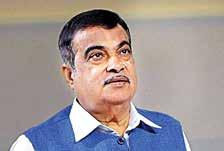
between Delhi and Mumbai will also be cut down by about 280 km. Gadkari said the land acquisition for the highway has been completed and 32 contracts out of 60 have already been awarded.
Out of the 22 projects, six are 2250 km expressways to be built at a cost of 1.45 lakh crore while the remaining six are 5250 km long greenfield corridors to be built at a price of Rs 1.65 lakh crore. Besides the Delhi-Mumbai Express Highway, the trans-Rajasthan and transHaryana projects will be completed within the next three years.
Gadkari said that for the Delhi-Mumbai Express Highway, greenfield alignment has been selected in order to optimise construction and land acquisition costs and avoid habitation. He added that this project will unlock new economic opportunities in hinterland districts of Haryana, Rajasthan, Madhya Pradesh and Gujarat and better connectivity in these regions. The 22 projects are expected to provide alternative routes to diversify traffic, improve geometry and provide better connectivity for major towns, thereby reducing distance and travel time.
HC panel directs drafting of plan for curbing river pollution
A panel appointed by the Bombay High Court (HC) and the Maharashtra Pollution Control Board’s (MPCB) local unit directed by E Ravindran, MPCB state member secretary, to draft a proposal enlisting the measures to stop pollution of Panchganga river. He also asked the MPCB regional unit to provide portable machines to treat the waste water released from various establishments located in the textile town of Ichalkaranji. According to Uday Gaikwad, an expert on the panel, the main focus must be on maintaining the flow of the river. If the flow of the river remains stable, the pollution caused by effluents is minimised.
Amritsar observes National Road Safety Week
Amritsar Traffic Police, in collaboration with Social Welfare and Health Care Society and BBKDAV college, conducted a public awareness rally regarding road safety programmes on the occasion of the 31 st National Road Safety Week. The campaigners primarily focused on preventive actions from deadly accidents due to rash driving. They also distributed helmets to twowheeler drivers and girl students to ensure their safety. Mount Litera Zee School (MLZS) of Amritsar held a rally titled ‘United for Road Safety’ at Bhandari Bridge and raised slogans like ‘Safety is better than speed’, ‘accidents hurt, safety doesn’t’.
Hyderabad partners with RedBus to better first, last mile connectivity
Hyderabad Metro Rail Limited and L&T Metro Rail Hyderabad Limited joined hands with RedBus, and introduced ‘rPool’. With the new move, dedicated carpool zones will be set up along 18 metro stations across the city and users would be required to register on the app to avail the service. One can avail the service for rates as low as Re 1 per km for cars and bikes and can commute four times a day using the app. However, the commuter will have to pay in advance. RedBus will also be issuing 1000 smart metro cards to the initial users of the scheme through its kiosks at metro stations.
FSCM bus service to miss its launch deadline
Faridabad’s dedicated bus service, proposed to launch under the Faridabad Smart City Mission, is likely to miss its deadline of January 2020. The delay was due to lack of bidders for the project which was caused by the central government’s revision of vehicular emission standards. Monika Agarwal, Deputy CEO, FSCM said that due to the revision of emission standards, the DPR of the project would have to be reframed and the budget of the project will also be increased. Thus, it will take a minimum of six months for the formulation of the new DPR, the updated budget and for the buses to be manufactured and delivered on order.
BENGALURU: In order to facilitate the introduction of the central government’s ‘One Nation One Card’ policy, the Bangalore Metro Rail Corporation Limited (BMRCL) is planning to install Automatic Fare Collection Systems on trial basis at Baiyappanahalli, Mysuru Road and Majestic stations. The National Mobility Card will allow commuters in Bangalore to use multiple modes of transport like metro and buses run by the Bangalore Metropolitan Transport Corporation (BMT C). The card can also be used for paying parking fees and tolls, other than being used for retail shopping. However, the card will only be utilised to its full potential after transport corporations start updating their existing ticket vending systems. Ajay Seth, Managing Director, BMR CL, said that automated ticket vending facilities will be made available for commuters travelling from Mysuru Road to Baiyappanahalli on Purple Line by the end of March this year. Over four lakh commuters who use Namma Metro services every day, 62 per cent are using the smart card. BMR CL, which has issued more than 10 lakh smart cards (closed-loop cards), maintains that passengers can continue to use these cards. The Bangalore Metropolitan Transport Corporation is also gearing up for the introduction of the open-loop smart cards for commuters.
The Corporation had, even before the One Nation One Card policy was introduced by the central government, adopted the Public-Private Partnership (PPP) model for the implementation of a similar project. The trials of this system were started in January 2017 on two AC buses. However, the initiative failed due to a large number of glitches in the system. The BMTC is planning to float a tender in order to reintroduce smart cards. C Shikha, Managing Director, BMT C said, “The Electronic Ticketing Machines we are currently using meet the specifications for introducing national common mobility card. Now, our expert team is working on how to introduce the card and also consulting with BMR CL.”
Black carbon melting Gangotri faster
DEHRADUN: A study released by the Dehradun-based Wadia Institute of Himalayan Geology has revealed that the concentration of black carbon on the Gangotri Glacier has doubled in the last few years. The concentration of black carbon is measured by two weather stations which are located on the way to the Glacier. These stations have been monitoring black carbon deposits on the Gangotri Glacier since the last few years.
Dr P S Negi, scientist at Wadia’s

research group on ‘Geomorphology and Environmental Geology’ said that the data received from the weather stations has helped largely to know about seasonal variations in the black carbon concentrations. According to Dr Negi, the period between April and June witnesses the highest concentration of black carbon while the lowest concentration is witnessed in the month of August. He further said the main sources of black carbon include forest fires, wood burning and seasonal burning of crop residue along with tourist activities in the region. He further explained that the black carbon deposit on the glaciers results in absorption of more light and emission of infra-red radiation. This results in a spike in the temperature around the glacier and contributes to speeding up their melting process. The presence of black carbon in the atmosphere also causes changes in the local ecosystem, weather cycles and the regional weather patterns such as rain and snow precipitation patterns.
Australian bush fires doused by NEWSCAN | BRIEFS
heavy torrential rainfall
SYDNEY: Major relief for Australia as the heavy torrential rains finally doused many of the widespread wildfires. Sydney received 7 inches of rain between Sunday and Monday, highest in a day since 1992, according to the Bureau of Meteorology. The New South Wales (NSW) Rural Fire Service, fires still raging in the region have been reduced to 37 from more than 130 at the start of the year, after parts of the state were hit with several hundred millimeters of rain. The downpour is a welcome sign for drought struck farmers, who are facing the problem for several months now. Although the news of rainfall relieves the fire struck regions and drought areas, it is not entirely a positive news for the country. As a result of extensive rainfall, several parts of the country like NSW coast and parts of Queensland are experiencing major flash flooding. The torrential rains have also caused widespread power cuts in the eastern coast of Australia. Another concern that arises is the debris and ash of the wildfires could now be swept into the water supply. The NSW state’s water authority has confirmed that they will be monitoring the water quality and assessing if extra measures are required to check the ash and sediment mixing in the city’s water supply. Authorities also said that water can be drawn from elsewhere in the network if the need arises.

NEW DELHI: The Government of Delhi told the Delhi High Court, on January 23, that the unauthorised colonies falling under the ‘reserved’ or ‘notified forest’ areas will not be regularised under the Centre’s move of regularisation of the unauthorised colonies.
Although, the move incorporates the regularization of over 1,700 unautorised colonies in the capital, however, it is not clear how many out of the 170 colonies listed by the Government of Delhi were cleared for regularisation. The fact came in light after the submission made by the Delhi government’s Department of Forests and Wildlife before Justice G S Sistani and Justice A J Bhambhani. The department submitted its data after it was asked to clarify the effect of directions to regularise unauthorised colonies falling under notified forest areas and wildlife sanctuaries in Delhi.
Elaborating on the Supreme Court’s earlier ruling, Sanjoy Ghose, Delhi government’s Additional Standing Counsel said that prior approval from the Central government is required for carrying out any non-forest activity within any forest area. Therefore, listing the colonies falling under the reserved or forest land, the Delhi government said that in North Division there are 4 colonies, in South Division 114 colonies, and in West Division 52 colonies. Due to the Model Code of Conduct, legalisation of such settlements in the city has been parked. The process will resume once the Delhi Elections are over.
CCTVs, mobile apps to monitor cleanliness in UPSRTC buses The Uttar Pradesh State Road Transport Corporation (UPSRT C) will install CCTV s in every bus depot under its jurisdiction and follow the mobile app-based monitoring system. The new system will be in effect from March 2, 2020. According to UPSRT C, two CCTV s will be installed in each depot at the bus cleaning site to record bus cleaning on a daily basis. The corporation will further be launching the ‘Bus Cleaning Data Management Application’ by February 15, 2020.
Unlimited trips for `1400 in Mumbai’s Metro 1
Mumbai Metro 1, the city’s first elevated metro track of length 11.4 km and connecting Ghatkopar and Versova, will now offer commuters unlimited trips on a monthly pass. The maximum number of trips that a person could avail using a monthly pass was 45 for `1375. Now, there will be no bar on the number of trips for `1,400. The scheme will be in effect from January 23.
Mandi set to be HP’s first e-district
Mandi is set to be Himachal Pradesh’s first district to achieve the status of e-district. The target is set by Rugved Thakur, Deputy Commissioner, Mandi and his staff. The DC said that the district management is planning to host all kinds of certificates and other documentation of a person of Mandi district online soon. They have targeted April 1, 2020 for the complete implementation of the project. He further said that all offices across the district would be connected with a computer network with an aim to provide citizen’s common services online.
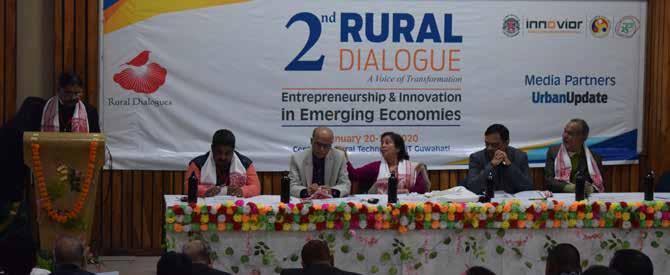
Promote rural entrepreneurship for a better India
(L-R) Dr H Purushotham, Chiarman & Managing Director, NRDC; Ashok Wankhade, Managing Editor, Urban Update; Kuladhar Saikia, Ex DGP Assam; Manjula Saikia Bhuyian IAS, Joint Secretary, Industries & Commerce Department, Govt of Assam; Prof T G Sitharam, Director, IIT Guwahati; Prof Sashindra Kumar Kakoty, Head, CRT Coordinator: UBA and RuTAG-NE, IIT Guwahati
The 2 nd Rural Dialogues was organized by All India Institute of Local Self-Government in collaboration with Innovior, a non-profit social enterprise and Indian Institute of Technology Guwahati (IIT-G) at the campus of the latter.
GUWAHATI : The primary objective of the two-day conference was to highlight innovation in rural areas of the North East India and give the emerging entrepreneurs of rural North East a platform. Prof T G Sitharam, inaugurated the conference. The eminent panel who addressed the conference included Manjula Saikia Bhuyan, Additional Secreatary, Industries and Commerce, Assam; Dr H Purusottam, Ashok Wankhade, Rajiv Kumar, amongst others. Over 40 experts took part in the deliberations, while about 30 entrepreneurs and innovators working in the rural areas participated in the event.
Addressing the conference first, Manjula Saikia Bhuyan highlighted the achievements of the Assamese state government in encouraging the startup culture in the region. In her address, she highlighted how the state government’s initiative “Startup Assam” is providing significant help to the young entrepreneurs of the state in taking forward their business ventures.
One of the key observation that came out of the dialogues was the ongoing water storage deficiency in rural parts of the area. The problem is unique to the region as unlike the majority of the country, the issue is not of water shortage but of storage space. Another thing that arose was the need to preserve the indigenous rural knowledge and technologies. They should be so upgraded so that a sense of belonging among the people is created.
Prof Sitharam, in his address, underlined the need to solve the water quality problem. Water is the cornerstone of life and Sitharam emphasized the need to build small dams to solve the problem of shortage in water storage facilities
Dr Kuladhar Sailda, president elect of the Assam Sahitya Sabha was critical of the urban bias in the introduction of new technologies. “It is high time that our policy makers realized the fact that our village folks do not want to live in their imagination, but they want to live in reality,” said Dr Saikia.
Prof S K Kakoty, head of the Centre for Rural Technology and Dean, Infrastructure, Planning and Management of IIT G, announced that the institute is currently implementing seven technologies which would help in changing the rural economy. Of them, six are its own technologies while one was being developed by IIT -Bombay. The IIT Guwahati has now been able to deliver in the area of rural technology because of the collaboration of other agencies like the public sector units (PSUs), NGOs and government agencies. It now wants to expand its area of activities and with that goal the second rural dialogue is organised, said Prof Kakoty. Rajiv Kumar, Mission Director, Innovior, highlighted the importance of entrepreneurship in today’s economy. “The power to think differently and ahead of times for the betterment of mankind is what sets entrepreneurs apart. To the young entrepreneurs of India, I would like to say; each of you has something unique to contribute to the nations. You are the vehicles of change and instruments of India’s transformation.
Cities to finalize roadmap for SDGs Curtain Raise r
at South Asian Cities Summit in Goa
All India Institute of Local Self-Government (AIILSG) along with a host of national and international partners is organising a two-day summit in Goa. The theme of the Summit is ‘10 Years to Sustainable Development Goals (SDGs)’. A total of 100 international delegates from 35 countries will be participating in the event and around 60 mayors from Indian cities will also take part
South Asian Cities Summit 5 10 Years to SDGs Enabling linkages between SDGs and city development to build better urban future
March 5-6, 2020 | Cidade de Goa | Goa, India
Team Urban Update
AIILSG is organising the 5 th South Asian Cities (SAC) Summit to be held on March 5 th and 6 th , 2020 at Hotel Cidade de Goa, Goa. Through the Summit, AII LSG wishes to spread knowledge and promote resource-sharing, innovative ideas and technologies, and help build better cities for future generations. AII LSG has organized 4 editions of SAC Summit since inception of the event in 2013. SAC Summit has witnessed participation of city mayors, municipal officials, policy makers, experts and the general public in large numbers from more than 50 countries. Through its previous editions on themes like ‘Smart Cities – Aspirations and Challenges’, ‘Connecting Cities, Building Knowledge’ and ‘New Urban Agenda and SDGs’, the SAC Summit has managed to share detailed information, spread awareness and develop an understanding of some of the most important issues that urban areas face today. This year, the theme of the Summit is ’10 years to SDGs’. The 2030 Agenda for Sustainable Development, adopted by all United Nations Member States in 2015, provides a shared blueprint for peace and prosperity for people and the planet, now and into the future. At its heart are the 17 Sustainable Development Goals (SDGs), which are an urgent call for action by all countries – developed and developing – in a global partnership. AII LSG has made efforts for participants to come together, share knowledge and learn from experiences of others. For its 5 th edition, the Summit will host over 80 speakers who will share their views and opinions on issues like ‘urban sanitation’, ‘e-mobility’, ‘building inclusive cities’ and ‘circular economy’, among others.
A few prominent speakers who will be participating in the conference are Pramod Sawant, Chief Minster, Government of Goa; Uday Madkaikar, Mayor, Corporation of the City of Panaji; Jerome Pons, Ambassador, European Union; Dr M Ramachandran, IAS (Retd), Former Secretary, Ministry of Urban Development, Government of India; Dr Sudhir Krishna, Former Secretary (Urban Development), Government of India; Dr Rakesh Kumar, Director, Council of Scientific and Industrial Research (CSIR ); Prof TG Sitharam, Director, Indian Institute of Technology-Guwahati (IIT -G); Hitesh Vaidya, Director, National Institute of Urban Affairs (NIUA); Dr H Firdaus, Mayor, Pekanbaru Municipality, Sumatra, Indonesia along with Jerome Pons, Head of Cooperation, European Union and Kulwant Singh, Former Asia Advisor, UN-Habitat. United Cities and Local Governments—Asia Pacific (UCLGASPAC), World Bank, European Union, United Nations University (UNU), NALAS, CIT YNET, J CLAIR , FSLGASri Lanka, Municipal Association of Bangladesh (MAB), MUAN-Nepal, and several other distinguished national and international organizations have also recognized the efforts of AII LSG and SAC Summit, and they will be represented during the Summit to support it and its endeavors. The two day summit will be divided into a total of six sessions and an inaugural and valedictory session.
Sustainability central theme at the Even t
50 th World Economic Forum in Davos
DAVOS: 2020 marked the 50th year of the flagship annual meetings of the World Economic Forum. The invitationonly meeting brought together several prominent global figures ranging from politicians, representatives from academia along with big names from the private sector to deliberate over this year’s theme ‘Stakeholders for a Cohesive and Sustainable World’. The theme couldn’t have been more relevant given the current scenario and the moral imperative that weighs upon us to be custodians of the planet for the sake of the next generation implies that we must act today. The forum aims to improve the state of the World in the coming 50 years, by offering its platform for putting forth the common good. The keyword at the World Economic Forum Annual Meeting 2020 was “stakeholder responsibility”. The gathering of eminent stakeholders was urged to act against the world’s most pressing environmental, social, and governance (ESG) issues. An interesting development from this year was that the stakeholders, primarily the private sectors interest towards the climate issues. Achim Steiner, Administrator, United Nations Development Programme (UNDP), said, “The WEF Forum is a unique opportunity to discuss development and economic trends while advocating for the private sector to become part of addressing some of the greatest issues of our time. One of the interesting trends, one could observe in Davos this year, is how much the corporate world is now focusing on some of the key environmental risks such as climate change and biodiversity loss that are shaping the economy of tomorrow, which will be a green economy,” In an encouraging development, new members signed up to the Forum’s Alliance of CEO Climate Leaders, committed to helping companies meet the Paris Climate Goals. Platforms and partnerships were launched to foster inclusive and sustainable growth
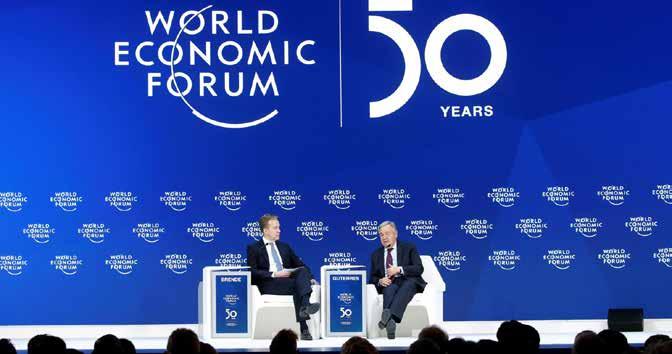
globally. The Forum and its stakeholders also deliberated on measures to better understand the implications of deploying artificial intelligence. In a bid to incorporate the concept of inclusive growth across the globe, The International Business Council, incorporating 140 of the world’s largest companies, agreed to support efforts to develop a core set of common metrics and disclosures that can be used to measure private-sector progress on ESG goals. A strategic partnership was signed between the World Economic Forum and the Organisation for Economic Cooperation and Development (OECD) to accelerate progress towards inclusive and sustainable growth globally.
For climate change mitigation The Forum also moved towards improving the state of climate and environment by becoming a founding partner of an alliance with Refinitiv and the United Nations of The Future of Sustainable Data Alliance which
Achim Steiner Administrator, UNDP
will focus on improving the quality of climate and environmental data for companies and investors. 1t.org, a new multi-stakeholder effort to support efforts to grow, conserve and restore 1 trillion trees by the end of the decade was announced. Within the first days of its launch, Colombia announced to plant 180 million trees by 2022, Salesforce committed to plant 100 million trees and Pakistan also committed to plant 2 billion trees. 1T was also supported by the United States of America, China and Saudi Arabia as part of its G20 Presidency. The Forum’s network of Global Shapers also committed to planting one million trees by next year across its 400 hubs worldwide. New members signed up to the Forum’s community of CEO Climate Leaders. The community is committed to helping companies meet the Paris Climate Goals.
For global benefit The meeting also marked the launch of the Reskilling Revolution. With this, WEF will aim to provide better education, skills and jobs to a billion people by 2030 with the initial backing of the governments of India along with Brazil, France, Pakistan, the Russian Federation, UAE and the US as well as many important companies.
As the world faces a possibly new epidemic in Corona Virus, CEPI, the Coalition for Epidemic Preparedness Innovations which was launched in Davos in 2017, announced the initiation of three programmes to develop vaccines against the novel coronavirus, nCoV-2019 in partnership with Moderna and the Wellcome Trust. The World Economic Forum also announced a partnership with the Global CEO Initiative (CEOi) to form a coalition to accelerate treatments for Alzheimer’s disease. Ministers in Davos announced negotiations between 99 economies on a new international agreement on investment facilitation at the World Trade Organization. The agreement aims to make it easier for investment to flow between economies while increasing its development impact. The US and France agreed a détente on digital taxation during the Annual Meeting, the Forum received a mandate from multi stakeholder partners to further build understanding of and encourage input into international tax reforms. The Forum also partnered with the Japanese government to launch a multi stakeholder effort to find practical mechanisms to enable “Data Free Flow with Trust” in support of the Osaka Track process that was initiated at the G20 in 2019.
Forming a Sustainable World and marching towards SDGs The Sustainable Markets Initiative, backed by a Sustainable Markets Council, was launched by The Prince of Wales in collaboration with the Forum aimed at bringing about a transition to sustainable financial markets and rapid industry decarbonization. The Forum’s Advanced Manufacturing and Production community launched the Carbon Reduction in Manufacturing Initiative to achieve a goal of cutting carbon emissions in manufacturing by 50% by 2030. The Sustainable Development Goals were also addressed at the meeting. The ‘Frontier 2030’ was launched as a platform to leverage the technologies of the Fourth Industrial Revolution to accelerate the SDGs. The Food Action Alliance was launched by the Forum, the International Fund for Agricultural Development (IFAD) and over 20 global leaders to strengthen the sustainability of the world’s foods systems through better nutrition, climate adaption and access to finance. A new multi-stakeholder partnership, SDG500, was launched to mobilize $500 million towards achieving the SDGs in emerging markets through a series of six blended finance funds.
Discussion on technological advancement The Forum partnered with a community of 40 central banks, international organizations, academic researchers and financial institutions to create a framework to help central banks evaluate, design and potentially deploy Central Bank Digital Currency (CBDC). The Forum, in collaboration with 100 stakeholders, produced the Empowering AI Toolkit to help board members better understand the positive and negative implications of deploying artificial intelligence. Partners of the Centre for the Fourth Industrial Revolution Global Network, including Brazil, Colombia, Japan and Saudi Arabia, expanded their commitment to ensuring responsible and ethical governance of smart city technologies through the G20 Global Smart Cities Alliance on Technology Governance, led by the World Economic Forum. The World Economic Forum’s Global AI Council, launched in 2019, collaborated with UNICEF to create guidelines for AI-supported toys for the under sevens, as well as identifying young people under the age of 18 to sit on a Global AI Youth Council. A group of private-sector leaders from major cybersecurity companies, services providers and global corporations along with leading law enforcement agencies, Interpol and Europol, agreed to work together with the Forum through 2020 to foster a global public-private alliance against cybercrime. A group of telecommunications stakeholders endorsed new principles combatting high-volume cyberattacks that could protect up to 1 billion consumers in 180 countries. A community of key stakeholders from international organizations, government and business was formed to reinforce cyber resilience in global aviation.










